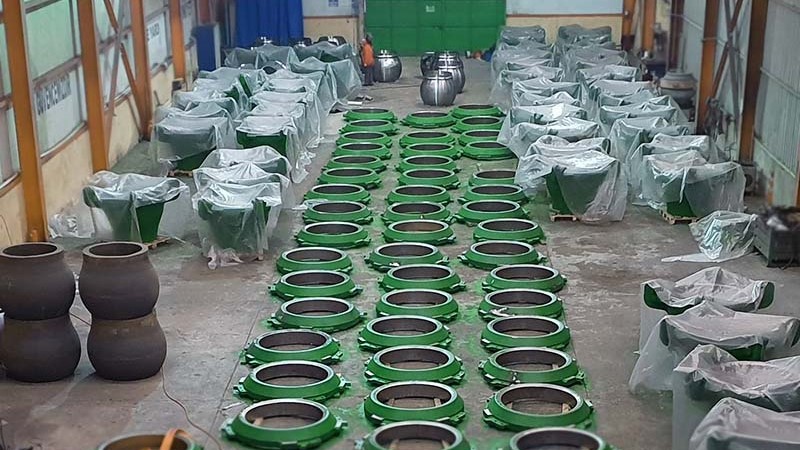In early 2019, Dredge Yard, based in The Netherlands, delivered a second batch of 50 heavy-duty dredge ball joints to a customer in the Middle East. Dredge Yard delivered the first group of ball joints in late 2018, for a capital dredging project already in operation in the Gulf region. The ball joints are joining pipeline that covers about 1.5 kilometers (about 0.93 miles).
Dredge ball joints are used as a flexible connection or coupling between steel pipelines.
“Steel pipelines need flexible connections for two reasons. First, it is a floating pipeline, which is exposed to many natural forces, such as waves, currents, wind, etc. Therefore, it must be flexible in order to endure the movement and natural forces under different operation conditions,” said Michel Debo, Dredge Yard operations manager. Secondly, cutter suction dredges that use pipelines must swing in all different directions, and the pipeline must mimic the same flexibility.
Ball joints also function during dredging operations as easy coupling and discoupling connection points in the pipeline, allowing the contactor to shorten or lengthen the pipeline as need, as the operation moves closer and farther from the discharge area.
The ball, which is placed inside the dredge ball joint casing, is what gives the pipeline its flexibility and allows it to tilt in all directions.
A dredge ball joint is made of many different parts – the case, ball, gland, liner and seal. Each part is manufactured individually and joined together. The liner and rubber seal are mounted on the case. Then, the ball is placed in position and locked using a gland (locking ring). View an animation of this process here: https://youtu.be/6Zl4beHi8iA?t=101.
Debo said the case and ball are made of carbon steel, providing high elongation and impact value. The gland is made of chromium, nickel and a molybdenum alloy, providing high tensile, high yield and high hardness value. The liner is made of ductile manganese iron or hard chromium iron for wear resistant properties. The seal is an NBR 70.
“The production of ball joints begins by creating patterns made of aluminum or hard wood, in order to ensure that all parts cast are identical and interchangeable,” Debo said. After casting, the components are heat treated to International Organization for Standardization (ISO) and American Society for Testing and Materials (ASTM) standards.
He said the heat treatment achieves the mechanical properties required for international standardization. “More specifically, heat treatment changes the properties of the material (for example, making it harder, more durable), until it reaches the standard international requirements. This ensures ball joint durability and quality,” Debo said.
Each dredge ball joint is cast in the required shape with extra machining allowance. A high accuracy vertical CNC machine is used to shape each component. “The CNC machine is necessary to provide accuracy, ensuring that each part is identical and interchangeable,” Debo said. This process will also smooth the surface of each component for low friction operation.
It took about three months to machine 50 dredge ball joints. Dredge Yard manufactures the part at its manufacturing facility in collaboration with its partners in the Republic of Turkey.
Dredge Yard and some third-party operations then perform a number of quality control tests. The chemical composition and mechanical properties tests are performed by a third party. Dredge Yard also performs measurement tests of all dimensions after casting and after machining. It runs a hardness test and assembly test for all parts.

Additional testing includes ultra-sonic testing for 20 percent of all surfaces, magnetic particle tests and dye penetrant inspections, which are used to make sure that the casing material meets quality standards. A surface roughness test ensures that the surface is smooth enough to allow optimal flexibility in the pipeline. A locking fix and release test on multiple joints inspects the functionality of the locking ring (gland) by locking and unlocking it.
In addition to quality control tests, static and dynamic tests look at the ball joints under standard operational conditions. A static test will pressure the joint to 10 bar over the required operational pressure. The dynamic test involves applying movement to the joint (simulating the movement during dredging operations), while the joint is pressurized.
The ball joints for this project are suitable for a continuous pressure of at least 30 bar, and Debo said the standard range for a ball joint is 10 to 30 bar. The ball joints have been designed using FEM (fine element metal) analysis, which uses computer software to model how the product reacts to different physical effects/forces, such as heat, pressure, vibrations and motion, to simulate how the ball joint would perform under different conditions.
In the field, two parts of the ball joint are welded to the steel pipeline. Thick heavy welds ensure the system can withstand the needed pressure.
Dredge Yard produces ball joints and other dredge components, such as dredge pumps, valves, pipes, auger heads and cutter heads. Dredge Yard also manufactures small to medium-sized dredges – plain suction, water injection, auger and cutter suction dredges.




